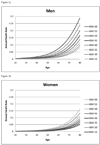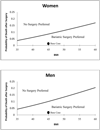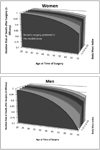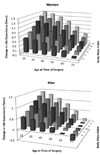Decision modeling to estimate the impact of gastric bypass surgery on life expectancy for the treatment of morbid obesity
- PMID: 20083755
- PMCID: PMC2862372
- DOI: 10.1001/archsurg.2009.240
Decision modeling to estimate the impact of gastric bypass surgery on life expectancy for the treatment of morbid obesity
Abstract
Objective: To create a decision analytic model to estimate the balance between treatment risks and benefits for patients with morbid obesity.
Design: Decision analytic Markov state transition model with multiple logistic regression models as inputs. Data from the 2005 National Inpatient Survey were used to calculate in-hospital mortality risk associated with bariatric surgery and then adjusted for 30-day mortality. To calculate excess mortality associated with obesity, we used the 1991-1996 National Health Interview Survey linked to the National Death Index. Bariatric surgery was assumed to influence mortality only through its impact on the excess mortality associated with obesity, and the efficacy of surgery was estimated from a recent large observational trial.
Intervention: Gastric bypass surgery. Main Outcome Measure Life expectancy.
Results: Our base case, a 42-year-old woman with a body mass index of 45, gained an additional 2.95 years of life expectancy with bariatric surgery. No surgical treatment was favored in our base case when the 30-day surgical mortality exceeded 9.5% (baseline 30-day mortality, 0.2%) or when the efficacy of bariatric surgery for reducing mortality decreased to 2% or less (baseline efficacy, 53%).
Conclusions: The optimal decision for individual patients varies based on the balance of risk between perioperative mortality, excess annual mortality risk associated with increasing body mass index, and the efficacy of surgery; however, for the average morbidly obese patient, gastric bypass improves life expectancy.
Figures






Similar articles
-
Impact of bariatric surgery on life expectancy in severely obese patients with diabetes: a decision analysis.Ann Surg. 2015 May;261(5):914-9. doi: 10.1097/SLA.0000000000000907. Ann Surg. 2015. PMID: 25844968 Free PMC article.
-
Life expectancy benefits of gastric bypass surgery.Surg Innov. 2006 Dec;13(4):265-73. doi: 10.1177/1553350606296324. Surg Innov. 2006. PMID: 17227925
-
A comparison of diet and exercise therapy versus laparoscopic Roux-en-Y gastric bypass surgery for morbid obesity: a decision analysis model.J Am Coll Surg. 2003 Mar;196(3):379-84. doi: 10.1016/S1072-7515(02)01754-4. J Am Coll Surg. 2003. PMID: 12648689
-
Rate of Death and Complications in Laparoscopic and Open Roux-en-Y Gastric Bypass. A Meta-analysis and Meta-regression Analysis on 69,494 Patients.Obes Surg. 2016 Aug;26(8):1956-63. doi: 10.1007/s11695-016-2231-z. Obes Surg. 2016. PMID: 27189352 Review.
-
Risk stratification of serious adverse events after gastric bypass in the Bariatric Outcomes Longitudinal Database.Surg Obes Relat Dis. 2012 Nov-Dec;8(6):671-7. doi: 10.1016/j.soard.2012.07.020. Epub 2012 Sep 11. Surg Obes Relat Dis. 2012. PMID: 23058451 Review.
Cited by
-
Cost-effectiveness of bariatric surgical procedures for the treatment of severe obesity.Eur J Health Econ. 2014 Apr;15(3):253-63. doi: 10.1007/s10198-013-0472-5. Epub 2013 Mar 24. Eur J Health Econ. 2014. PMID: 23526126 Free PMC article.
-
"I didn't see this coming.": why are postbariatric patients in substance abuse treatment? Patients' perceptions of etiology and future recommendations.Obes Surg. 2012 Aug;22(8):1308-14. doi: 10.1007/s11695-012-0668-2. Obes Surg. 2012. PMID: 22661046
-
Examining the BMI-mortality relationship using fractional polynomials.BMC Med Res Methodol. 2011 Dec 28;11:175. doi: 10.1186/1471-2288-11-175. BMC Med Res Methodol. 2011. PMID: 22204699 Free PMC article.
-
Bariatric Surgery in Patients with Existing Ostomy: A Preliminary Feasibility Study.Bariatr Surg Pract Patient Care. 2022 Jun 1;17(2):127-130. doi: 10.1089/bari.2021.0131. Epub 2022 Jun 8. Bariatr Surg Pract Patient Care. 2022. PMID: 35765305 Free PMC article.
-
Predictors of bariatric surgery among an interested population.Surg Obes Relat Dis. 2014 May-Jun;10(3):547-52. doi: 10.1016/j.soard.2013.09.014. Epub 2013 Sep 30. Surg Obes Relat Dis. 2014. PMID: 24355320 Free PMC article.
References
-
- Hedley AA, Ogden CL, Johnson CL, Carroll MD, Curtin LR, Flegal KM. Prevalence of overweight and obesity among US children, adolescents, and adults, 1999–2002. JAMA. 2004 Jun 16;291(23):2847–2850. - PubMed
-
- Arterburn DE, Maciejewski ML, Tsevat J. Impact of morbid obesity on medical expenditures in adults. Int J Obes Relat Metab Disord. 2005 Mar;29(3):334–339. - PubMed
-
- Arterburn D. Obesity. Am Fam Physician. 2002 Oct 1;66(7):1279–1280. - PubMed
-
- Arterburn DE, Crane PK, Veenstra DL. The efficacy and safety of sibutramine for weight loss: a systematic review. Arch Intern Med. 2004 May 10;164(9):994–1003. - PubMed
-
- Li Z, Maglione M, Tu W, et al. Meta-analysis: pharmacologic treatment of obesity. Ann Intern Med. 2005 Apr 5;142(7):532–546. - PubMed
Publication types
MeSH terms
Grants and funding
LinkOut - more resources
Full Text Sources
Medical

